Thanks for posting. I was trying to visualize how the stern-mounting would look. Looks like a good installation.Finally got to the boat to work on electronics up grade. Photographed my two diaphragm pumps in the aft compartment. Been very happy with this set up.
You are using an out of date browser. It may not display this or other websites correctly.
You should upgrade or use an alternative browser.
You should upgrade or use an alternative browser.
Factory original bilge pumps in 32-3
- Thread starter peaman
- Start date
Isn't it just one Y-valve? That's what I did here to let two electric pumps share (alternately) a single remaining bilge hose:I was thinking about keeping my Rule 1500 as a backup and plumbing it into the manual bilge pump hose, but I couldn't figure out a way to bypass the manual pump without using multiple Y valves.

Granted, space is much tighter with the 1.5" hoses, but a 1.5" Y-valve is cheap and standard plumbing fare.
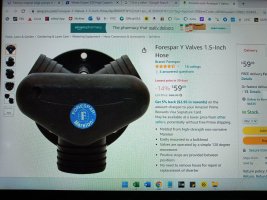
Last edited:
peaman
Sustaining Member
The pump I bought just a few months ago, and recently installed, has no joker valve, just the over-size snout. An elbow snout is available to those who shop around. But the straight snout, which adds length to the pump, is what motivated me to start this thread, since this newer design cannot directly replace the snout-less pump which it replaces.The snout screws off to reveal the joker valve.
Bolo
Contributing Partner
Notice that I put in two 90 degree elbows. This was to prevent kinking in the hoses because of some of the tight turns I had to make.Thanks for posting. I was trying to visualize how the stern-mounting would look. Looks like a good installation.
My boat was originally set up with a 1.5" hose on the manual bilge pump. If you split that with a tee or y valve, the water would have to go through the manual bilge pump to get out of the boat. Does your 1.5" hose go to a manual pump as well?Isn't it just one Y-valve? That's what I did here to let two electric pumps share (alternately) a single remaining bilge hose:
View attachment 45832
Granted, space is much tighter with the 1.5" hoses, but a 1.5" Y-valve is cheap and standard plumbing fare.
View attachment 45833
Ah, now I get it. That does present a different problem. The picture I showed feeds 2 rule centrifugals in the bilges and just dumps out to a thru hull.If you split that with a tee or y valve, the water would have to go through the manual bilge pump to get out of the boat.
I do have a Whale Gusher manual with 1.5" hose installed, but I need to replace the old corrugated 1.5" hose (which may be impossible to remove). I'm thinking about just running a new 1.5" hose above the TAFG for the Whale Gusher. After abandoning the old corrugated hose, I suppose I could use it as conduit to push another 3/4 to 1-1/4" bilge hose through, and then I could abandon the Y-valve setup I'm now using for the Rule pumps. Still would have to add, or Tee onto, a through-hull though.
Last edited:
Interesting. I just bought a "new" Rule 500 spare yesterday because the old ones seem to be unavailable.The pump I bought just a few months ago, and recently installed, has no joker valve, just the over-size snout.
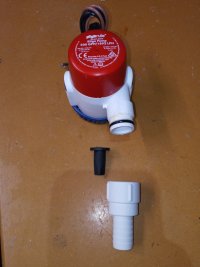
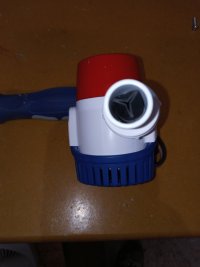
The joker valve reduces the ID of the outlet to just over 3/8", but apparently Rule finds this acceptable.
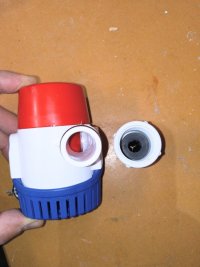
Added: West Marine had these yesterday at $30 (cheaper than Amazon). The lady at the register told me if it fails at any time in the next 3 years, to bring it back and she'd sell me the West Marine protection plan ($10-15) after the fact, and then allow me to grab a new pump off the shelf.
Last edited:
bsangs
E35-3 - New Jersey
Isn't it just one Y-valve? That's what I did here to let two electric pumps share (alternately) a single remaining bilge hose:
View attachment 45832
Granted, space is much tighter with the 1.5" hoses, but a 1.5" Y-valve is cheap and standard plumbing fare.
View attachment 45833
That Forespar Y valve is exactly what I have with 1.5" hoses. I keep it turned to the automatic feed, except when I'm checking to make sure the manual hand pump works. (Which we all check regularly, right?
@Christian Williams - I believe it's a manual Whale gusher pump, but cannot say for certain. Honestly, I check to make sure it works (it does) and don't really fiddle with it otherwise, so I'm not as familiar with it as am the centrifugal Rule. I do plan to change the rather large metal intake shoe that sits in the bilge to a more compact version, sometime before the shrink wrap comes off in a few weeks.
bsangs
E35-3 - New Jersey
@trickdhat - Here you go. I made a trip over today because my interest had been piqued about the bilge setup after this discussion. So bear with me as I attempt to break this down. (And again, I got the boat this way, so if this setup is insane, attack the PO!  ) For brevity's sake, I didn't include pictures from the bilge itself. In a nutshell, the Rule centrifugal is in one chamber, the Whale Gusher shoe and hose connection is in another, and it T's into a 1.5" white corrugated hose that leads aft.
) For brevity's sake, I didn't include pictures from the bilge itself. In a nutshell, the Rule centrifugal is in one chamber, the Whale Gusher shoe and hose connection is in another, and it T's into a 1.5" white corrugated hose that leads aft.
Here is the first photo, in the cockpit starboard lazaret. The lower "white" 1.5" hose comes from the bilge. It will transport water from the Rule centrifugal, and from the manual Whale Gusher. The black Y valve diverter will send it up toward the Whale (upper black hose) or toward the bilge thru hull (more to come on that).

Here you can see the hose going from the diverter to the Whale. You'll also notice the looped black hose behind the Whale. Well... (Yes, I am now aware that I should get those wires secured away from the Whale.)
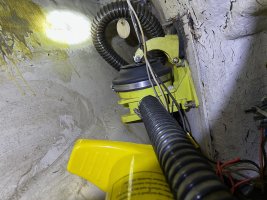
That's the 1.5" hose connected to the other outlet of the diverter. It loops around like that, then T's back into the main bilge 1.5" drainage line after the Whale.
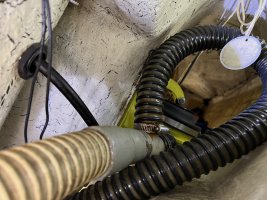
And the bilge then exits here. As you can see, the PO left what I assume was the original diaphragm bilge pump hoses - and thru hull - intact.
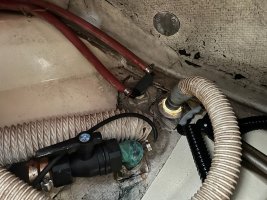
So that's how it works. And it does work, even if it seems nutty. Why it was changed so dramatically, I'm not sure. If any of the experts think this is disaster waiting to happen, please let me know,
Here is the first photo, in the cockpit starboard lazaret. The lower "white" 1.5" hose comes from the bilge. It will transport water from the Rule centrifugal, and from the manual Whale Gusher. The black Y valve diverter will send it up toward the Whale (upper black hose) or toward the bilge thru hull (more to come on that).

Here you can see the hose going from the diverter to the Whale. You'll also notice the looped black hose behind the Whale. Well... (Yes, I am now aware that I should get those wires secured away from the Whale.)

That's the 1.5" hose connected to the other outlet of the diverter. It loops around like that, then T's back into the main bilge 1.5" drainage line after the Whale.

And the bilge then exits here. As you can see, the PO left what I assume was the original diaphragm bilge pump hoses - and thru hull - intact.

So that's how it works. And it does work, even if it seems nutty. Why it was changed so dramatically, I'm not sure. If any of the experts think this is disaster waiting to happen, please let me know,
Last edited:
Not saying I understand it, so instead some questions:
The Rule pump in the bilge sends its output into the 1.5" "white" hose, which it shares with the Whale pump?
How is that connection made (the 3/4" Rule to the bigger Whale hose)? Since the single output hose has to go uphill, does the Rule have to pump the 1.5" hose full of bilge water before the bilge water exits at the stern? Is there a lot of backwash?
The factory system used separate red hoses for main bilge and shower bilge, combined to exit the boat together, as in your photo. The 1.5" hose was exclusive to the Whale diaphragm pump for both pickup and discharge.
There is often a reason for things, which I miss.
The Rule pump in the bilge sends its output into the 1.5" "white" hose, which it shares with the Whale pump?
How is that connection made (the 3/4" Rule to the bigger Whale hose)? Since the single output hose has to go uphill, does the Rule have to pump the 1.5" hose full of bilge water before the bilge water exits at the stern? Is there a lot of backwash?
The factory system used separate red hoses for main bilge and shower bilge, combined to exit the boat together, as in your photo. The 1.5" hose was exclusive to the Whale diaphragm pump for both pickup and discharge.
There is often a reason for things, which I miss.
bsangs
E35-3 - New Jersey
Not saying I understand it, so instead some questions:
The Rule pump in the bilge sends its output into the 1.5" "white" hose, which it shares with the Whale pump?
How is that connection made (the 3/4" Rule to the bigger Whale hose)? Since the single output hose has to go uphill, does the Rule have to pump the 1.5" hose full of bilge water before the bilge water exits at the stern? Is there a lot of backwash?
The factory system used separate red hoses for main bilge and shower bilge, combined to exit the boat together, as in your photo. The 1.5" hose was exclusive to the Whale diaphragm pump for both pickup and discharge.
There is often a reason for things, which I miss.
There’s a coupler used to attach the Rule to the beginning of the 1.5” hose.
Not much backwash to speak of. Maybe a splash or two. You can hear it when the pump stops spinning, but nothing measurable ever comes back. Not sure how full the hose gets before emptying, but it exits right quick. (The Whale is another matter. Takes some pumping to get it going, but it goes.)
Mind you I THINK that's how it works. I could be deciphering it incorrectly, but believe I'm on the right track.
Last edited:
The Rule 2000 has a 1-1/8" discharge outlet so it wouldn't work with the original 3/4" hose.How is that connection made (the 3/4" Rule to the bigger Whale hose)?
I kind of like the setup. It hasn't taken any capability away from the boat (the Whale Gusher manual still works). And while it hasn't increased your high-output pumping rate (you can only use the Whale or the Rule at any one time), it does give you the option of a high output electric pump instead of being held captive at the stern with a pump handle in your hand. This could be critical if you are solo and need to be "forward" in the boat, trying to stop a leak.So that's how it works. And it does work, even if it seems nutty. Why it was changed so dramatically, I'm not sure. If any of the experts think this is disaster waiting to happen, please let me know,
As to why the PO made so many changes (abandoning two factory-mounted diaphragm pumps) for your current setup? My guess is he was worried about total pumping capacity. For all the praise Jabsco diaphragm pumps get around here, they are comparatively (to centrifugals) pretty inefficient. Consider a 200A-hour battery bank depleted to 50% capacity:
A Jabsco 37202 uses 7.5 A to pump 270 gph. So your boat's original total electric pumping capacity was about 7 hrs of pumping 540gph (with 2 Jabsco pumps) or 3780 gallons total.
A Rule 2000 draws 4.8A. I know, everybody says Rule exaggerates their pump output. Lets give them that. Say the Rule 2000 only pumps 1000gph at 4.8A That's still 21 hrs of pumping 1000 gph, or 21,000 gallons total. That's 5.5 times the output of the Jabscos even after discounting their output by 50%.
Not saying one pump is better than the other. They are designed to satisfy different sets of criteria. Owners should consider that when choosing which pump to use in which application. One thing to consider in your set-up might be inspecting/replacing those old corrugated bilge hoses.
Last edited:
I think that would work OK. There's a couple disadvanatages to the system if I'm understanding it correctley:@trickdhat - Here you go. I made a trip over today because my interest had been piqued about the bilge setup after this discussion. So bear with me as I attempt to break this down. (And again, I got the boat this way, so if this setup is insane, attack the PO!) For brevity's sake, I didn't include pictures from the bilge itself. In a nutshell, the Rule centrifugal is in one chamber, the Whale Gusher shoe and hose connection is in another, and it T's into a 1.5" white corrugated hose that leads aft.
Here is the first photo, in the cockpit starboard lazaret. The lower "white" 1.5" hose comes from the bilge. It will transport water from the Rule centrifugal, and from the manual Whale Gusher. The black Y valve diverter will send it up toward the Whale (upper black hose) or toward the bilge thru hull (more to come on that).
View attachment 45842
Here you can see the hose going from the diverter to the Whale. You'll also notice the looped black hose behind the Whale. Well... (Yes, I am now aware that I should get those wires secured away from the Whale.)
View attachment 45843
That's the 1.5" hose connected to the other outlet of the diverter. It loops around like that, then T's back into the main bilge 1.5" drainage line after the Whale.
View attachment 45845
And the bilge then exits here. As you can see, the PO left what I assume was the original diaphragm bilge pump hoses - and thru hull - intact.
View attachment 45846
So that's how it works. And it does work, even if it seems nutty. Why it was changed so dramatically, I'm not sure. If any of the experts think this is disaster waiting to happen, please let me know,
- You are down to a single bilge pump
- the shower sump will always be filled up to the limber hole
- The centrifugal pump relies on the check valve. If it fails open, the pump wont be able to pump overboard.
The good news is it sounds like you have the old hose and diaphragm pumps still installed and working. If you added some float switches and manual/auto switches, they could become you're everyday nuisance water pumps keeping both bilges dry. You also have a high capacity centrifugal pump plumbed to a large diameter hose, so you could mount that a little higher and keep it as an emergency backup.
A side note on your exhaust thru hull. I had the same configuration and the small hose connector was an anti syphon that was no longer in use. it had corroded and created a hole where exhaust water was leaking back into the boat. Yours looks exactly like mine did before I changed it out (I added double hose clamps right after this pic was taken).


bsangs
E35-3 - New Jersey
Thank you. I’ll be sure to take a closer look at that.I think that would work OK. There's a couple disadvanatages to the system if I'm understanding it correctley:
- You are down to a single bilge pump
- the shower sump will always be filled up to the limber hole
- The centrifugal pump relies on the check valve. If it fails open, the pump wont be able to pump overboard.
The good news is it sounds like you have the old hose and diaphragm pumps still installed and working. If you added some float switches and manual/auto switches, they could become you're everyday nuisance water pumps keeping both bilges dry. You also have a high capacity centrifugal pump plumbed to a large diameter hose, so you could mount that a little higher and keep it as an emergency backup.
A side note on your exhaust thru hull. I had the same configuration and the small hose connector was an anti syphon that was no longer in use. it had corroded and created a hole where exhaust water was leaking back into the boat. Yours looks exactly like mine did before I changed it out (I added double hose clamps right after this pic was taken).
View attachment 45850View attachment 45851
EDIT: It's also my understanding that there is no check valve on these Rule pumps. And the fact that some water does backwash (very, very little) when the pump stops spinning would seem to indicate that's the case, unless I'm completely misunderstanding the check valve. There IS a check valve - more like a check flap - where the Whale pump hose T's into the main bilge hose however, which prevents any water from getting into it when not in use.
Last edited:
I don't understand why. Can't the two red 3/4" hoses (Tee-d together at the stern) still serve smaller electric pumps?
- You are down to a single bilge pump
Yeah, that was annoying for me. Always water across all the bilges. You can seal the mast/shower bilge limber hole with epoxy.
- the shower sump will always be filled up to the limber hole
I assumed the check valve was on the Whale gulper's suction intake from the bilge. If so, the centrifugal doesn't have to pump against it. The check valve just prevents the centrifugal's flow from just exiting through the Whale Gulper's suction intake. Suction through the Rule (by pumping the Whale Gulper) likely wouldn't present any problem. Maybe???
- The centrifugal pump relies on the check valve. If it fails open, the pump wont be able to pump overboard.
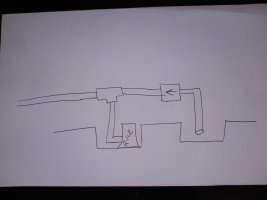
Edited: RTFQ: I first read this as "If the [valve] fails closed.." which is not what you said. Yeah, if it fails open, the Rule just pumps back into the next bilge section.
Last edited:
bsangs
E35-3 - New Jersey
Exactly, @Kenneth K. That's the only check valve in the setup from my understanding.I don't understand why. Can't the two red 3/4" hoses (Tee-d together at the stern) still serve smaller electric pumps?
Yeah, that was annoying for me. Always water across all the bilges.
I assumed the check valve was on the Whale gulper's suction intake from the bilge. If so, the centrifugal doesn't have to pump against it. The check valve just prevents the centrifugal's flow from just exiting through the Whale Gulper's suction intake. Maybe???
View attachment 45852
Those two red hoses are there, but not connected to anything currently. The PO cut them at the pumps. So while you can find the red hoses in the bilge and at the stern, they are currently useless. Something I will remedy as backup.
I don't use the shower a lot yet, so that hasn't been a big issue. But when there is water in the bilge - mainly freshwater from the mast - yes, it travels to all chambers due to the limber holes.
I may have misunderstood, but I thought bsangs said the factory bilge pumps were still there but disconnected. They hoses can still be used, but in the current configuration, they're down to 1
The pump won't be pumping through the check valve under normal operation, but if the check valve is stuck open the water from the centrifugal pump will take the path of least resistance which would be back into the bilge through the open check valve.
The pump won't be pumping through the check valve under normal operation, but if the check valve is stuck open the water from the centrifugal pump will take the path of least resistance which would be back into the bilge through the open check valve.
bsangs
E35-3 - New Jersey
You understood correctly, though I originally misunderstood the check valve discussion. Yes and Yes on both notes. I'll be reconnecting those hoses to the old pumps though.I may have misunderstood, but I thought bsangs said the factory bilge pumps were still there but disconnected. They hoses can still be used, but in the current configuration, they're down to 1
The pump won't be pumping through the check valve under normal operation, but if the check valve is stuck open the water from the centrifugal pump will take the path of least resistance which would be back into the bilge through the open check valve.
Looking at it further, I don't think you would need the T and check valve in the bilge. The centrifugal pump could just function as a strum box for the manual pump. With both in place, the manual pump is probably pumping through the centrifugal pump anyway. with the addition of the original diaphragm pumps, and lifting the centrifugal pump to function as an emergency backup, I think this setup would be perfect. Thanks @bsangs for the posts and pics!
Genius!I don't think you would need the T and check valve in the bilge. The centrifugal pump could just function as a strum box for the manual pump.
Put a plug in the open Whale Gulper inlet hose, dump a few gallons of water in the bilge, and test to verify manual pumping is satisfactory. Remove the Tee if it is.
